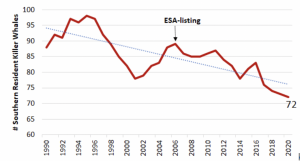11 Ocras in Puget Sound
Tyler Wu
Introduction
In 2018, a total of over 300,000 ferry travelled the Salish Sea, while 6,330 cargo, container and passenger vessels, plus 1,124 oil tankers and barge tows entered Washington wasters, much of the traffic heading towards the Port of Vancouver on the West Coast (Mapes, 2019a). The ships produce a type of sound for communication purposes in every season, day and night, while such sounds are noises in the same sonic sweet spot orcas for killer whales to hunt and communicate. As a result, the killer whales are troubled by the noise pollutions to hunt the scarce food, salmon, and thus are headed towards extinction (Mapes, 2019a).
In this context, it is critical to evaluate what interventions humans can take to mitigate the negative impacts of sound noise to killer whale? To explore answers to this research question, secondary data can be collected from various website sources such as BBC News, the Seattle Times, academic journal articles. This report will include three chapters. One is the introduction of general audience. The second section is about the link of this idea with the climate justice movement. The third section is about killer whale’s adaptation to deal with the issue of noise pollution.
Introduction of a general audience
The general public are the target audience of this topic. On the one hand, local people must be aware of the extinctive status of killer whale so that they can make efforts and make behavioral changes to alter the situation. On the other hand, people living outside the Northwest USA should learn from this lesson and take measures to protect animals in local wasters or forests. In all, people on the planet can take lessons from this report about the importance of conserving wild animals and helping them adapt to the changing environment.
Only 73 killer whale survives now (Mapes, 2019b). Figure 1 illustrates the sharp decline of number of killer whales, declining from the peak point of 98 in 1996 to 72 in 2020.

Figure 1. number of killer whales
Source: USA Oceana (2020)
The report of Mapes (2019a) highlights vessel noises as the primary reason to explain the decline of number of killer whales. In addition to vessel noise, there are other reason related to climate change, such as declining food resources (e.g. salmon) for killer whales and contaminants (e.g. CBs, DDT and other pesticides) (PTMSC, 2019; Mapes, 2019b). Specifically, it is explained that the habitats are impacted by intense effects of climate changes, which impacted the number of salmons (Mapes, 2019b). Therefore, climate change that has intense effects on different species’ habitats in the eco-system will post great threats to different species, ranging from salmon to killer whales. In this vein, killer whales’ food sources and inhabits are impacted by climate change. In other words, the survival of killer whale is both directly and indirectly affected by climate change.
Climate Justice movements
Since 2005, southern resident killer whales have been included in the list of federal protection. This endangered species list also includes the salmon. Consequently, any federal activities that are likely to impact the listed species are required to go through consultation with NOAA. (Mapes, 2019b). However, it is concerned that simply listing salmon and killer whale into the endangered animal list is not enough. More measures should be taken to protect the coastal habitat which is paramount to survival of species like killer whale.
In addition to legislative change, a research program was started by Northwest Fisheries Science Center in 2003 to fill data gaps and investigate how different potential threats impact the population of killer whale. Based on better understanding about killer whale and its living environment, local organization and authority can help inform conservation and recovery efforts at the state, national and international levels (NOAA Fisheries, 2020). Henceforth, ecosystem research is a complementary part of protective measures to prevent the extinction of killer whales. In addition, the research programs require financial supports from either profitable or non-profitable organizations, such as Lindblad Expeditions-National Geographic (LEX-NG) Fund (Gable, 2017). They learned that not only government and local authoritative institution should engage in protection of killer whale, but also other relevant institutions, organizations and even individual citizens should be appealed to engage in the protection of killer whale.
Animals’ adaptation to the issues
While some plants and animal species are competent to adjust to new habitats and quickly occupy different landscape parts, however the rare and endangered species are likely to be less abundant and even end in extinction (US Fish & Wildlife Service, 2020). Compared with sea anemone, killer whale has much slower speed to adapt to environmental changes and thus much weaker capability to keep up with rapid shifts in suitable climates and habitats (US Fish & Wildlife Service, 2020). When the killer whales are slow to adapt to environmental changes, their population will be threatened. This assumption is backed by the fact that only 73 killer whales survive. The population of killer whales has declined sharply in the past years because of climate change and changing inhabits. What is more, as revealed by a research of killer whale, according to different food supply, different types of killer whale have different ways to adapt to climate changes (Gable, 2017). This research finding is important for humans to intervene with different types of measures to help killer whale to adapt to the changing climate.
Conclusion
In conclusion, climate change and other human activities such as vessel noises threaten the survival of killer whale in the Northwest USA. It is important to research this topic because the survival of killer whale is related to the diversity of species on the planet and thus related to the world’s sustainable development. Given killer whale has much weaker capability to adapt to changing environment, appropriate human interventions should be considered. It is important for different parties to get involved to help killer whales adapt to the changing inhabits.
Media Attributions
- number of killer whales

